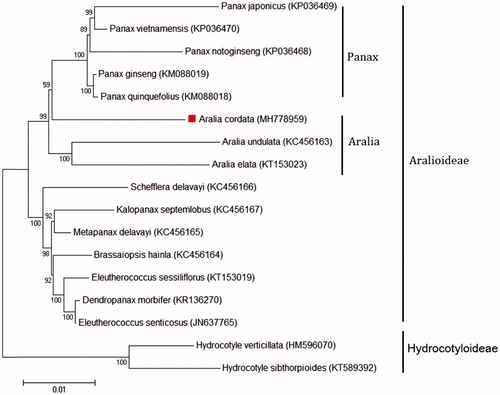Abstract
Aralia (A.) cordata is an important oriental herb belonging to the family Araliaceae. The A. cordata complete chloroplast genome was 156,087 bp, and consisted of a large single copy (LSC) region (86,101 bp), a small single copy (SSC) region (18,052 bp) and two inverted repeats (IRs) (25,967 bp). It was predicted to contain 158 genes, including 105 protein-coding genes, eight ribosomal RNAs, and 45 transfer RNAs. The phylogenetic analysis suggests that A. cordata is closely related to the Panax genus of Araliaceae family, and A. cordata (subfamily: Aralioideae) is definitely separated the Hydrocotyloideae subfamily.
Aralia cordata is an upright herbaceous perennial plant which belongs to the family Araliaceae. This plant has long been recognized as therapeutic herbs for anti-dementia, antioxidant, and anti-inflammatory activities in China, Japan, and Korea (Cho et al. Citation2009). A sample was obtained from Jeollabukdo medicinal resource research institute (http://www.jbares.go.kr/, voucher number: JA20170995, geographic coordinate: 35°46′38″N, 127°22′42″E) in Jinan, Korea. A total of 5.85 Gbp of data was obtained using the Illumina MiSeq platform (Illumina Inc., San Diego, CA). Whole genome sequencing was performed using the Illumina Genome Analyzer platform (HiSeq4000, Illumina Inc., San Diego, CA). Reads were assembled using CLC Assembly Cell package, version 4.2 (CLC Inc., Aarhus, Denmark). We analyzed the complete chloroplast genome by selecting the contigs associated with the chloroplast genome and by expanding, integrating, gap-filling the selected contig. The chloroplast genome was annotated using the Dual Organellar GenoMe Annotator (DOGMA) program (Wyman et al. Citation2004) and deposited into GenBank under accession number MH778959.
The A. cordata chloroplast genome was 156,087 bp in length, and has a circular structure with a large single copy (LSC) region of 86,101 bp, a small single copy (SSC) region of 18,052 bp and a pair of 25,967 bp inverted repeats (IRs). Genome annotation revealed 158 functional genes including 105 protein-coding genes, eight ribosomal RNAs, and 45 transfer RNAs. The organization and contents of these genes are similar to those previously reported species belonging to the Araliaceae family (Long et al. Citation2017). However, rps12 splicing gene was located at exons 1, 2, 3, 4, and 5 positions, and ycf1, ycf 2, and ycf15 in the IR regions are pseudogene. A phylogenetic analysis was performed using the chloroplast genome of A. cordata with 16 Araliaceae family species, including 14 the Aralioideae subfamily and two Hydrocotyloideae subfamily. Phylogenetic relationships were revealed to compare using 77 common protein-coding sequences. The phylogeny indicated that A. cordata most closely related to the Panax genus than Aralia genus, and A. cordata (subfamily: Aralioideae) is definitely separated the Hydrocotyloideae subfamily ().
Figure 1. Phylogeny of A. cordata and 16 related species based on complete chloroplast genome sequences. The phylogenetic tree was constructed using maximum likelihood analysis with 1000 bootstrap replicates based on the complete chloroplast genomes of 17 species from the Araliaceae family, including 15 the Aralioideae subfamily and two Hydrocotyloideae subfamily.

Geolocation
The genomic DNA sample used for sequencing was obtained from the Oriental Medicine Resource Center of Wonkwang University (geographic coordinate: N 35°56′38″, E 126°57′16″).
Disclosure statement
The authors report no conflicts of interest.
Additional information
Funding
References
- Cho SO, Ban JY, Kim JY, Jeong HY, Lee IS, Song KS, Bae K, Seong YH. 2009. Aralia cordata protects against amyloid beta protein (25–35)-induced neurotoxicity in cultured neurons and has antidementia activities in mice. J Pharmacol Sci. 111:22–32.
- Long G, Shen L, Chen Q, Li X, Zhang L. 2017. The complete chloroplast genome sequence of Hydrocotyle sibthorpioides (Apiales: araliaceae). Mitochondrial DNA Part B. 2:29–30.
- Wyman SK, Jansen RK, Boore JL. 2004. Automatic annotation of organellar genomes with DOGMA. Bioinformatics. 20:3252–3255.
